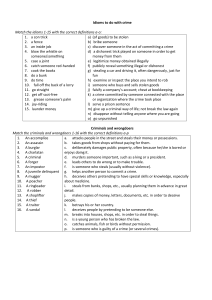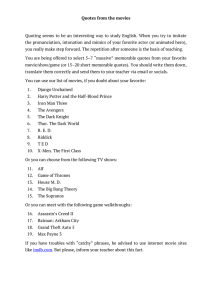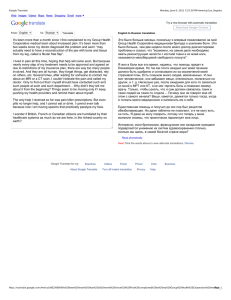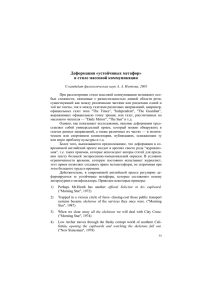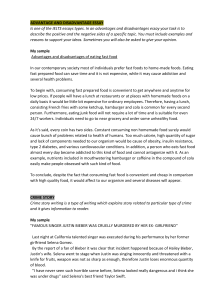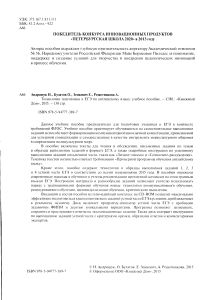Lawenglish
реклама
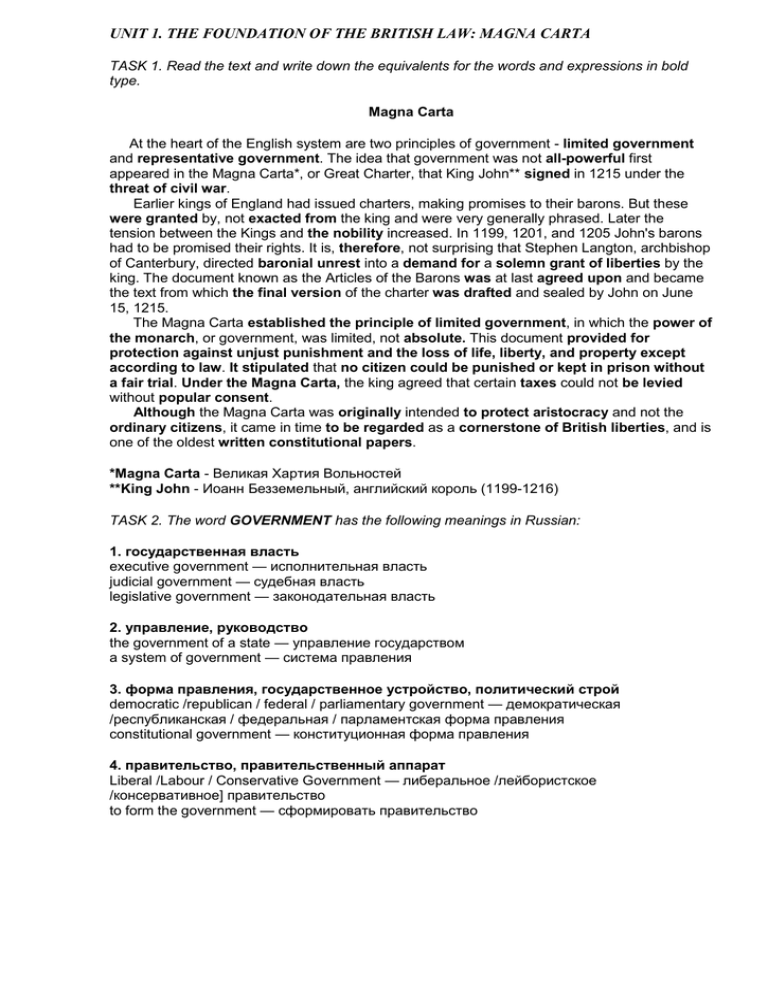
UNIT 1. THE FOUNDATION OF THE BRITISH LAW: MAGNA CARTA TASK 1. Read the text and write down the equivalents for the words and expressions in bold type. Magna Carta At the heart of the English system are two principles of government - limited government and representative government. The idea that government was not all-powerful first appeared in the Magna Carta*, or Great Charter, that King John** signed in 1215 under the threat of civil war. Earlier kings of England had issued charters, making promises to their barons. But these were granted by, not exacted from the king and were very generally phrased. Later the tension between the Kings and the nobility increased. In 1199, 1201, and 1205 John's barons had to be promised their rights. It is, therefore, not surprising that Stephen Langton, archbishop of Canterbury, directed baronial unrest into a demand for a solemn grant of liberties by the king. The document known as the Articles of the Barons was at last agreed upon and became the text from which the final version of the charter was drafted and sealed by John on June 15, 1215. The Magna Carta established the principle of limited government, in which the power of the monarch, or government, was limited, not absolute. This document provided for protection against unjust punishment and the loss of life, liberty, and property except according to law. It stipulated that no citizen could be punished or kept in prison without a fair trial. Under the Magna Carta, the king agreed that certain taxes could not be levied without popular consent. Although the Magna Carta was originally intended to protect aristocracy and not the ordinary citizens, it came in time to be regarded as a cornerstone of British liberties, and is one of the oldest written constitutional papers. *Magna Carta - Великая Хартия Вольностей **King John - Иоанн Безземельный, английский король (1199-1216) TASK 2. The word GOVERNMENT has the following meanings in Russian: 1. государственная власть executive government — исполнительная власть judicial government — судебная власть legislative government — законодательная власть 2. управление, руководство the government of a state — управление государством a system of government — система правления 3. форма правления, государственное устройство, политический строй democratic /republican / federal / parliamentary government — демократическая /республиканская / федеральная / парламентская форма правления constitutional government — конституционная форма правления 4. правительство, правительственный аппарат Liberal /Labour / Conservative Government — либеральное /лейбористское /консервативное] правительство to form the government — сформировать правительство TASK 3. Match the following English expressions to their Russian equivalents: 1. 2. 3. 4. 5. 6. 7. 8. 9. 10. 11. 12. 13. 14. 15. 16. 17. 18. 19. 20. 21. arbitrary government authoritarian government colonial form of government government investigation government of the day government offices government official government party government(al) department government(al) regulation government's term of office Her Majesty's Government local government military government mixed government organs of government parliamentary government presidential government provisional government representative government to dissolve the government a. b. c. d. e. f. g. h. i. j. k. l. m. n. o. p. q. r. s. t. u. действующее правительство местное самоуправление военная администрация смешанная форма правления парламентское правление правительство Её Величества правящая партия правительственные учреждения представительная форма правления временное правительство распустить /расформировать/ правительство органы государственного управления автократия президентская власть авторитарная форма правления правительственное ведомство правительственное расследование колониальная форма государственного устройства постановление правительства правительственный чиновник срок правомочий правительства TASK 4. Answer the questions: 1. What were the two basic principles of the English system of government at the beginning of the 13th century? How do you understand these principles? 2. What political situation necessitated the granting of the Magna Carta? 3. What provisions did the Magna Carta contain? 4. Who enjoyed the rights granted by the Magna Carta? TASK 5. Render the following passage into English paying attention to the words and expressions in bold type: Великая Хартия Вольностей Великая Хартия Вольностей - это грамота, подписанная в 1215 английским королем Иоанном I. Она составлена на латинском языке и содержит 63 статьи. Этот документ был подписан в результате недовольства баронов усилением королевской власти, налоговым гнетом и неудачной внешней политикой короля. Большинство статей отражало и защищало интересы аристократии. Однако, другие сословия также получили значительные права. Великая Хартия Вольностей гарантировала соблюдение королем определенных обязательств по отношению к баронам, запрещала королю взимать налоги без согласия подданных. Хартия положила начало свободе личности. Ни один человек не мог быть арестован, заключен в тюрьму, лишен собственности или покровительства законов, изгнан или подвергнут иной каре иначе, как по суду равных ему и согласно законам страны. Это был первый в истории Англии документ, ограничивающий власть короны и провозглашающий права и свободы подданных. Великая Хартия вольностей стала краеугольным камнем английских свобод. Ряд ее статей получили развитие в Акте Хабеас Корпус и Билле о правах. Великая Хартия вольностей сыграла важнейшую роль в английской истории. Она и сейчас входит в число действующих актов конституции Великобритании. UNIT 2. THE FOUNDATION OF THE BRITISH LAW: HABEAS CORPUS ACT “Let the Body Be Brought...” In the United States, Britain, and many other English-speaking countries, the law of Habeas Corpus guarantees that nobody can be held in prison without trial. Habeas Corpus became a law because of a wild party held in 1621 at the London home of a notoriously rowdy lady, Alice Robinson. When a constable appeared and asked her and her guests to quiet down, Mrs. Robinson allegedly swore at him so violently that he arrested her, and a local justice of the peace committed her to jail. When she was finally brought to trial, Mrs. Robinson’s story of her treatment in prison caused an outcry. She had been put on a punishment diet of bread and water, forced to sleep on the bare earth, stripped, and given 50 lashes. Such treatment was barbaric even by the harsh standards of the time; what made it worse was that Mrs. Robinson was pregnant. Public anger was so great that she was acquitted, the constable who had arrested her without a warrant was himself sent to prison, and the justice of the peace was severely reprimanded. And the case, along with other similar cases, led to the passing of the Habeas Corpus Act in Britain in 1679. The law is still on the British statute books, and a version of it is used in the United States, where the law was regarded as such an important guarantee of liberty that Article 1 of the Constitution declares that “Habeas Corpus shall not be suspended except in cases of rebellion or invasion”. Habeas Corpus is part of a Latin phrase - Habeas corpus ad subjiciendum - that means “Let the body be brought before the judge.” In effect, a writ of Habeas Corpus is an order in the name of the people (or, in Britain, of the sovereign) to produce an imprisoned person in court at once. TASK 1. Find in the text the English equivalents for the following words and expressions: 1. мировой судья 2. ордер на арест 3. варварское отношение 4. восстание; мятеж, бунт 5. вторжение, нападение, нашествие 6. недовольство общественности 7. печально известный 8. заключить в тюрьму 9. вызвать гневный протест 10. привести к принятию закона 11. получить строгий выговор 12. предстать перед судом 13. быть оправданным 14. быть приостановленным 15. от имени народа / монарха Retell the text using the words and expressions above. TASK 2. Work with a dictionary. Find the definitions of the following legal terms. trial writ statute Use each word in sentences of your own. TASK 3. Render the following passage into English paying special attention to the words and expressions in bold type: Хабеас Корпус Хабеас Корпус Акт - это закон, принятый в 1679 английским парламентом. Согласно этому закону, судьи были обязаны по жалобе лица, считающего свой арест или арест кого-либо другого незаконным, требовать срочного представления арестованного суду для проверки законности ареста или для судебного разбирательства. Заключение обвиняемого в тюрьму могло производиться только по предъявлении ордера с указанием причины ареста Хабеас Корпус - это существовавшее издревле, по некоторым данным, еще до Великой Хартии вольностей, понятие английского права, которым гарантировалась личная свобода. Ни один свободный человек не мог быть посажен в тюрьму без предписания Хабеас Корпус, посредством которого судья повелевал доставить к нему обвиняемого (букв. тело, corpus). ROLE-PLAY Let the Body Be Brought! Imagine the following situation: You have been arrested and imprisoned. No warrant has been produced. Your friend or lawyer comes to see you in prison. Tell him about your problem and ask him to take appropriate steps. Appoint another student as a judge who will do justice. .................... UNIT 3. THE STUDY OF CRIME TASK 1. Match the following headings with the sections of the text below: History Application Techniques Subject Objectives Criminology (1) Criminology is a social science dealing with the nature, extent, and causes of crime; the characteristics of criminals and their organizations; the problems of apprehending and convicting offenders; the operation of prisons and other correctional institutions; the rehabilitation of convicts both in and out of prison; and the prevention of crime. (2) The science of criminology has two basic objectives: to determine the causes, whether personal or social, of criminal behavior and to evolve valid principles for the social control of crime. In pursuing these objectives, criminology draws on the findings of biology, psychology, psychiatry, sociology, anthropology, and related fields. (3) Criminology originated in the late 18th century when various movements began to question the humanity and efficiency of using punishment for retribution rather than deterrence and reform. There arose as a consequence what is called the classical school of criminology, which aimed to mitigate legal penalties and humanize penal institutions. During the 19th century the positivist school attempted to extend scientific neutrality to the understanding of crime. Because they held that criminals were shaped by their environment, positivists emphasized case studies and rehabilitative measures. A later school, the "social defense" movement, stressed the importance of balance between the rights of criminals and the rights of society. (4) Criminologists commonly use several research techniques. The collection and interpretation of statistics is generally the initial step in research. The case study, often used by psychologists, concentrates on an individual or a group. The typological method involves classifying offenses, criminals, or criminal areas according to various criteria. Sociological research, which may involve many different techniques, is used in criminology to study groups, subcultures, and gangs as well as rates and kinds of crime within geographic areas. (5) Criminology has many practical applications. Its findings can give lawyers, judges, and prison officials a better understanding of criminals, which may lead to more effective treatment. Criminological research can be used by legislators and in the reform of laws and of penal institutions. TASK 2. Find in the text the English equivalents for the following: 1. криминология рассматривает природу и причины преступлений 2. изучение обстоятельств правонарушения по материалам дела 3. криминология опирается на открытия других наук 4. проблемы задержания преступников 5. проблемы предотвращения преступлений 6. применение на практике 7. исправительные учреждения 8. установить корни преступного поведения 9. установить причины преступности 10. выработать действующие принципы 11. смягчить наказание 12. подвергнуть сомнению TASK 3. Replace the words and expressions in bold type with words and expressions that mean the same. The objectives of criminology and criminalistics are rather different. The system of penal institutions is to be reformed. The scientific study of criminals originated in the late 18th century. Modern criminologists hold that criminals are shaped by a multiplicity of factors. Criminology studies the factors that lead to violent behaviour. TASK 4. Match the legal terms on the left with their definitions on the right. Use them in sentences of your own. 1) Deterrence a) guidance and instruction given to offenders, their beneficial treatment aimed at restitution of positive skills and attitudes 2) case study b) measures taken to prevent hostile action 3) legislator c) a person serving a prison sentence 4) retribution d) a detailed analysis of a criminal person or group 5) convict e) a member of a body which gives or makes laws 6) rehabilitation f) something given or demanded in repayment, especially punishment TASK 5. Answer the following questions: 1. 2. 3. 4. What steps can society take to cope with crime? What trends can be observed in the development of criminology? What methods and techniques are applied in criminology? In what other spheres of life can criminology find a useful application? Active vocabulary: Criminololgy криминология, criminal (convict) преступник, correctional institutions исправительные учреждения, prevention of crime предупреждение преступления, hereditary causes of crime наследственные (генетические) причины преступления, lawyer юрист, judge судья, case study изучение материалов дела. TASK 1. Match the following headings with the sections of the text below: History Application Techniques Subject Objectives Criminology (1) Criminology is a social science dealing with the nature and causes of crime; the characteristics of criminals and their organizations; the operation of prisons and other correctional institutions; the rehabilitation of convicts (criminals) both in and out of prison; and the prevention of crime. (2) The science of criminology has two basic objectives: to determine the causes (personal or social), of criminal behavior and to establish principles for the social control of crime. Criminology draws on the findings of biology, psychology, psychiatry, sociology, anthropology, and others. (3) Criminology originated in the late 18th century. During the 19th century the positivist school tried to think about scientific neutrality to the understanding of crime. A later school, the "social defense" movement, stressed the importance of balance between the rights of criminals and the rights of society. (4) Criminologists use several research techniques. The collection and interpretation of statistics is the initial step in research. The case study, often used by psychologists, concentrates on an individual or a group. The typological method involves classifying criminals, or criminal areas. Sociological research is used in criminology to study groups, subcultures, and gangs. (5) Criminology has many practical applications. Its findings can give lawyers, judges, and prison officials a better understanding of criminals, which may lead to more effective treatment. TASK 2. Find in the text the English equivalents for the following: 1. 2. 3. 4. 5. 6. 7. 8. 9. криминология рассматривает природу и причины преступлений криминология опирается на открытия других наук предотвращение преступлений исправительные учреждения сбор и обработка данных статистики права преступников антропология преступное поведение реабилитация преступников TASK 3. Answer the following questions: What does criminology deal with? What are the basic objectives of criminology? When did criminology originate? What are the main techniques of criminology? What sciences are connected with criminology? TASK 6. Read the text and write down the Russian equivalents for the words and expressions in bold type. Cesare Lombroso (1836 – 1909) Professor Lombroso is a criminologist whose views, though not altogether correct, caused a lot of interest and made other people look into the problem of crime in a more scientific way. He is regarded as the father of the scientific study of criminals, or criminology. Lombroso studied at the universities of Padua, Vienna, and Paris, and later he became a professor of psychiatry and forensic medicine, a director of a mental asylum. In an enormous book called The Criminal, he set out the idea that there is a definite criminal type, who can be recognized by his or her appearance. Some of what he said is difficult to believe. For example, he said that left-handed persons have a criminal instinct. Among the things he considered important were the shape of the head, colour of the hair, the eyes, the curve of the chin and forehead and if the ears stick out. Lombroso's theories were widely influential in Europe for a time, but his emphasis on hereditary causes of crime was later strongly rejected in favour of environmental factors. Lombroso tried to reform the Italian penal system, and he encouraged more humane and constructive treatment of convicts through the use of work programs intended to make them more productive members of society. TASK 7. Complete the following text with the words from the box. Translate the text. criminal types; capital punishment; inmates; case studies; upbringing; investigations; suspended; multiple; unthinkable; rehabilitative. Cesare Lombroso, professor of psychiatry and anthropology at the University of Turin, sought through firsthand observation and measurement of prison _________ to determine the characteristics of _______. Some of his __________ allowed him to establish the existence of “hereditary criminals”. Lombroso held that such criminals exhibit a higher percentage of physical and mental anomalies than do noncriminals. Among these anomalies, were various unusual skull sizes and asymmetries of the facial bones. Other scholars helped to introduce the ideas that crime has ________ causes and that most criminals are not born criminal but are shaped by their __________ and associations. Thus, the emphasis in criminology had turned to experimental _____ _____ and to preventive and _______ measures. Without this contribution into the scientific study of criminals the presentday alternatives to ____________ and old-fashioned imprisonment such as probation, ________ sentence, fines, and parole would have been _________. TASK 8. Answer the following questions: 1. What is Cesare Lombroso famous for? 2. How did he try to relate criminal behaviour to a person’s appearance? 3. What was Lombroso’s contribution to the development of penal system? TASK 9. Render the following article into English paying special attention to the words and expressions in bold type. ПРЕСТУПНИКАМИ РОЖДАЮТСЯ ИЛИ СТАНОВЯТСЯ? Преступность: Врожденное и Приобретенное Более ста лет назад итальянский врач Чезаре Ломброзо создал галерею “преступных типов”, чем обессмертил свое имя. Он, например, утверждал, что покатый лоб, квадратный подбородок, грубые черты лица, длинные руки, и мускулистое телосложение говорят о врожденных преступных наклонностях. Понадобилось много лет, пока теория прирожденного преступника сошла на нет, потеряла свое влияние. Тем не менее и в наши дни продолжаются споры о наследовании преступных качеств и о биологических предпосылках преступного поведения. Послевоенный экономический рост породил у западных лидеров опасное заблуждение, что с любыми общественными проблемами можно справиться, проводя соответствующую социальную политику и увеличивая бюджетные отчисления. Тогда казалось, что, давая человеку больше благ, можно смягчить и даже изменить его природу. Времена изменились, и стало ясно, что ни либеральные реформы, ни коммунистический диктат не привели к обществу процветания. В 1979 г. в Центре изучения близнецов и усыновленных детей в США начали наблюдать несколько сотен двойняшек и тройняшек. Все они были разлучены вскоре после рождения и воспитывались в разных концах Англии и Америки. Экспериментаторы исходили из предположения, что, если близнецы идентичные, все различия, возникшие впоследствии, следует отнести за счет разной среды обитания. Однако, исследования показали, что различия между детьми, воспитанными раздельно, и близнецами, росшими в одной семье, практически отсутствуют. Другое исследование, проведенное в Дании, показало, что дети преступников, даже если их воспитывать в домах добропорядочных граждан, в большей степени склонны к конфликтам с законом, чем собственные отпрыски. Более того, есть все основания считать, что, если один из разлученных однояйцевых близнецов имеет судимость за уголовное преступление, второй рано или поздно тоже свернет на скользкую дорожку. Некоторые исследователи идут еще дальше и считают, что первопричина многих видов правонарушения, в первую очередь таких тяжких, как убийства, разбойные нападения, изнасилования и поджоги - не социальная, а биологическая. Самый серьезный удар по “теории о среде” нанесла сравнительно молодая наука – социобиология. Исследования на животных показали, что у агрессивных обезьян уровень одного из гормонов – серотина – ниже, чем у пассивных. Это, вполне возможно, относится и к человеку – у людей, совершивших преднамеренные насильственные преступления, тоже наблюдается недостаток этого гормона. Так кто же виноват: среда или генетика? Unit 4.Civil Rights and Liberties: The Bill of Rights When the first Congress under the newly ratified Constitution met in late April of 1789, the most important item of business was the consideration of a proposal to add the 10 amendments, known as the Bill of Rights, to the Constitution. From the Bill of Rights Americans receive guarantees of such basic rights as free speech, freedom of the press and religion, the right to petition the government for redress of grievances, freedom from unreasonable search and seizure, freedom of assembly, the right to trial by jury and just compensation for property taken for the public good. Since the Bill of Rights was adopted, 16 other amendments have been added to the Constitution. But the Constitution is more than the total of written provisions and formal amendments. It is а document that has evolved and changed dramatically over 200 years, one that remains vital, alive and still controversial today. ТНЕ BILL OF RIGHTS AMENDMENT I Congress shall make no law respecting an establishment of religion, or prohibiting the free exercise thereof; or abridging the freedom of speech, or of the press, or the right to the people peaceably to assemble, and to petition the Government for а redress of griеvаnсеs. AMENDMENT II A well regulated Militia, being necessary to the security of а free State, the right of the people to keep and bear Arms, shall not be infringed. AMENDMENT III No Soldier shall, in time of peace be quartered in any house, without the consent оf the Owner, nor in time of war, but in а manner to be prescribed by law. AMENDMENT IV The right of the people to be secure in their persons, houses, papers, and effects, against unreasonable searches and seizures, shall not be violated, and no Warrants shall issue, but upon probable cause, supported by Oath of affirmation, and particularly describing the place to be searched, and the persons or things to be seized. AMENDMENT V No person shall be held tо answer for а capital, or otherwise infamous crime, unless on а presentment or indictment of а Grand Jury, except in cases arising in the land or naval forces, or in the Militia, when in actual service in time of War or public danger; nor shall any person be subject for the same offence to be twice put in jeopardy of life or limb, nor shall be compelled in any criminal case to be а witness against himself, nor be deprived of life, liberty, or property, without due process of law; nor shall private property be taken for public use without just compensation. AMENDMENT VI In all criminal prosecutions, the accused shall enjoy the right to а speedy and public trial, by an impartial jury of the State and district wherein the crime shall have been committed; which district shall have been previously ascertained by law, and to be informed оf the nature and cause of the accusation; to be confronted with the witnesses against him; to have compulsory process for obtaining witnesses in his favor, and tо have the assistance of counsel for his defence. AMENDMENT VII In Suits at common law, where the value in controversy shall exceed twenty dollars, the right of trial by jury shall be preserved, and no fact tried by а jury shall be otherwise reexamined in any Court of the United States, than according to the rules of the common law. AMENDMENT VIII Excessive bail shall not be required, nor excessive fines imposed, nor cruel and unusual punishments inflicted. AMENDMENT IX The enumeration in the Constitution of certain rights shall not be construed to deny or disparage others retained by the people. AMENDMENT X The powers not delegated to the United States by the Constitution, nor prohibited by it to the States, are reserved to the States respectively, or to the people. Thus, the Bill of Rights is a series of “thou shall nots” – restraints imposed upon government. Some of these restraints are substantial liberties, which put limits on what the government shall and shall not have the power to do – such as establishing a religion, quartering troops in private homes without consent, or seizing private property without just compensation. Other restraints are procedural liberties, which deal with how the government is supposed to act. These procedural liberties are usually grouped under the general category of due process of law, which first appears in the Fifth Amendment provision that “no person shall be…deprived of life, liberty, or property, without due process of law. Since liberty for some requires restraining liberty of others, the general status of civil liberties can never be fixed and permanent. Every provision in the Bill of Rights is subject to interpretation, and in any dispute involving a clause of the Bill of Rights, interpretations will always be shaped by the interpreter’s interest in the outcome. Unit 5. Women’s Rights The right to self-determination, the dignity of the individual, the essential equality of all human beings: these are not just slogans or theories in the modern world but matters of passionate conviction. Women were bound to respond to this dynamic current, bound to take а fresh look at the roles, which history and tradition, as well as biology, assigned to them. 17th Century Women The women, who first ventured into the American wilderness early in the 17th century and in the next 300 years took part in making it habitable, had а clear idea of what was expected of them. Both principle and practice seemed to make it plain that women were wholly subordinate to men, if not actually inferior in most respects. Rights and privileges were masculine concerns. The survival of such а view was challenged from the first by facts of existence. As soon as the first settlers followed the explorers and adventurers, women were desperately wanted and needed in America. А group of the earliest Virginia colonists headed а list of "necessities" sent back to England with the category "wives", and as the frontier moved steadily westward, the supply of women never seemed to keep up with the demand. But it was far more than scarcity that enhanced women' s value. The work they performed was at least as hard as а man's — and often included almost the same tasks. 19th Century Women The feelings about women underlying the conventional ideas of the 19th century continued to be а powerful influence. They determined that most working women should enter only certain occupations, and particularly those — such as textile and garment manufacturing and teaching — with some ostensible relationship to their traditional tasks. They determined that most married women would still devote themselves exclusively to family life. The conventional ideas persisted with remarkable vigor, and by а relatively small group of women in the 19th century were felt as an intolerable burden. These were the women who sought а place for themselves in higher education and professional careers and who fought for civil and political equality with men. In their own time they had to contend with ridicule, hostility, and their own doubts and dismay, but they are honored today for their part in opening to other women so many new doors. Among the leaders of women's suffrage movement in the 19th century were Elizabeth Cady Stanton and Susan В. Anthony. Susan B. Anthony was one of the founders of the National Woman Suffrage Association, the first organization to work for the right to vote for women. She helped to organize the 1848 Seneca Falls, New York, Women's Rights Convention, which issued the declaration that "all men and women are created equal." She worked tirelessly, by writing, lecturing, petitioning legislators, and organizing supporters, to achieve women's voting rights. She was subjected to verbal abuse and arrested in pursuit of her cause. Before her death in 1906, four states had granted women the right to vote. Her crowning achievement was yet to come some years later after her death. FIRST WOMEN’S RIGHTS CONVENTION It is а fact, however, that American women in one part of the country were apparently the first in the world to win equal voting rights with men. Thanks largely to the efforts of another determined woman, а large, plain-spoken, warmly witty storekeeper's wife named Esther Morris. Due to her efforts the Territory of Wyoming gave women the right to vote in 1869, and by 1916, sixteen states allowed women to vote. Finally, in recognition of their contribution to the war effort in World War I, the Nineteenth Amendment was ratified in 1920 giving all women the right to vote. The changes that have occurred since have given a woman, in sum, far more time, more strength, more money, and more incentives of various other kinds to see what those choices mean to her. 20th Century Women The main goal of the women’s rights movement in the early 20th century was to achieve equal pay for equal work. Women have experienced discrimination in employment since the founding of the nation. The issue has become а major one since the end of World War II when many women entered the job market. Job discrimination has taken two forms: access to jobs and pay for work done. Company employment practices and discrimination by male managers prevented women from getting work in other than traditional female jobs such as secretaries, low-skill factory workers, and household or restaurant service employees. Professional employment was limited to teaching and nursing. In many areas of employment in private industry, women who did the same work as men received less pay under the argument that men provided the primary family support. The Civil Rights Act of 1964 included Title VII, which banned discrimination in employment on the basis of sex, race and religion. Employers, employment agencies, and unions were required to end discriminatory practices in hiring, salary offers, and apprenticeship programs. Companies now identify themselves as "Equal Opportunity Employers" and employment ads no longer list jobs as "men wanted." Many women have taken positions, such as police officers, engineers, airline pilots, and construction workers, that were previously held exclusively by men. The Equal Access to Employment Act of 1972 encouraged the admission of more 5 women to colleges and professional schools. The Equal Employment Opportunity Act of 1972 required employers to provide equal pay for equal work. 21st Century Women America today is utterly accustomed to the look of all women going to or from work. Wives and mothers have made it their choice to combine jobs and family life. More than a third of the women of working age, are job-holders, and they make up a third of the labor force. The more education a woman has, the more likely she is to be at work, and more than half the women college graduates are employed. Legislation has allowed women to make significant gains in broadening their opportunities for employment; however, prejudices still block their advancement in some fields of employment. Though women now make up half of the work force in the nation their goals of equality have not been fully realized because men earn more on the average and continue to dominate in supervisory, management, and administrative positions. While the circumstances of women’s lives obviously no longer call for the heroism of their pioneer great-grandmothers, women today still face a lot of problems to deal with. Comprehension Quiz Directions (1-8): For each statement or question, choose the number of the word of expression that, of those given, best completes the statement or answers the question. 1) 1) What was the primary category on the list of necessities headed back to England by Virginia women? a) a) food necessities b) men c) wives 2) 2) When did the first women suffrage movement start? a) a) 17th century b) 18th century c) 19th century 3) 3) Who helped to organize Women’s Convention in 1848, in Seneca Falls, New York? a) a) Elizabeth Cady Stanton b) Susan B. Anthony c) Esther Morris 4) 4) Which territory first granted women the right to vote? a) a) New York b) Texas c) The Territory of Wyoming 5) 5) When did all women get the right to vote? a) a) 1869 b) 1916 c) 1920 6) 6) The main goal of the women’s rights movement in the early 20th century was to achieve… a) a) the right to vote b) equal pay for equal work c) the end of discrimination in hiring 7) 7) Women were prevented from getting work in other than traditional female jobs such as… a) a) secretaries b) engineers 8) 8) Which Act required employers to provide equal pay for equal work? a) a) The Civil Rights Act of 1964 (Title VII) b) b) The Equal Access to Employment Act of 1972 c) c) The Equal Employment Opportunity Act of 1972 Grammar Quiz: Fill in the blanks the right answer 1. The women of the early 17th century in America took part … making it habitable. a) at b) in c) of 2. Women were inferior … men in most respects. a) to b) with c) by 3. The work women performed was at least … а man's. a) so harder b) such hard c) as hard as 4. Fighting for the political equality with men women … to contend with ridicule, hostility. a) a) must b) had c) ought 5. Susan B. Anthony … to verbal abuse and arrested in pursuit of her cause. a) a) subjected b) suspected c) was subjected 6. American women were the first in the world … equal voting rights with men. a) to win b) win c) winning 7. The Nineteenth Amendment ratified in 1920 … all women the right to vote. a) has given b) was giving c) gave 8. Women … discrimination in employment since the founding of the nation. a) have experienced b) experience c) experienced 9. More than a third of the women of working age, are job-holders, and they … a third of the labor force. a) make out b) make up c) make off 10. The more education a woman has, the more likely she is … at work. a) a) being b) to be c) to being Lexical Quiz Directions: Choose the synonym among the given alternatives 1. to devote a) a) dedicate b) give in c) contribute 2. to contend a) a) struggle b) confront c) contradict 3. to grant a) a) admit b) gratify c) deliver 4. to ratify a) a) impose b) allow c) establish 5. to ban a) a) prohibit b) limit c) discriminate 6. burden a) a) weight b) load c) difficulty 7. suffrage a) a) suffering b) vote c) voice 8. effort a) a) entreatment b) engagement c) struggle 9. equality a) similar b) likeness c) parallel 10. conviction a) persuasion b) domination c) dissuasion 11. inferior a) a) weak b) passive c) second-rate 12. scarcity a) abundance b) poverty c) lack Clues: 12c, 11c, 10a, 9b, 10c, 9b, 8b, 7b, 6b, 5a, 4a, 3a, 2a, 1a
